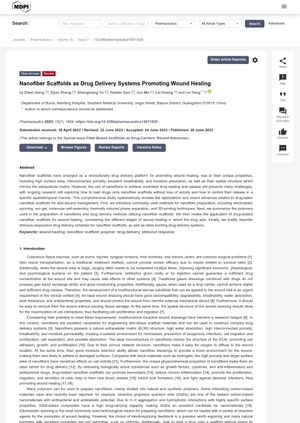Nanofiber Scaffolds as Drug Delivery Systems Promoting Wound Healing
June 2023
in “Pharmaceutics”

TLDR Nanofiber scaffolds help wounds heal by delivering drugs directly to the injury site.
The document reviews the use of nanofiber scaffolds as drug delivery systems for wound healing. These scaffolds, which mimic the extracellular matrix, are created using methods such as electrostatic spinning, sol–gel, molecular self-assembly, thermally induced phase separation, and 3D-printing techniques. They are made from a variety of natural and synthetic polymers, including chitosan, starch, alginate, hyaluronic acid, cellulose, collagen, silk fibroin, fibroinogen, polylactic acid (PLA), polyglycolic acid (PGA), polycaprolactone (PCL), and poly(lactic-co-glycolic) acid (PLGA). Drugs are loaded onto these scaffolds through physical adsorption, chemical conjugation, coating, and coblending electrospinning. The scaffolds can deliver drugs to promote hemostasis, reduce inflammation, and enhance cell proliferation. They can also carry growth factors, vitamins, and antibiotics to promote wound healing. Stimulus-responsive nanofiber scaffolds, which control drug release in response to environmental changes, are a new area of focus.
View this study on mdpi.com →
Cited in this study

research Sustained Release of EGF/bFGF Growth Factors by Mussel-Inspired Core-Shell Nanofibers with Hemostatic and Anti-Inflammatory Effects for Promoting Wound Healing
The new nanofiber improves wound healing by releasing growth factors, reducing inflammation, and helping skin regeneration.

research Probiotic-Functionalized Silk Fibroin/Sodium Alginate Scaffolds With Endoplasmic Reticulum Stress-Relieving Properties For Promoted Scarless Wound Healing
Probiotic-coated silk/alginate scaffolds help heal wounds faster and with less scarring.